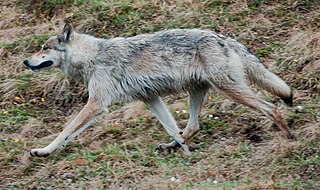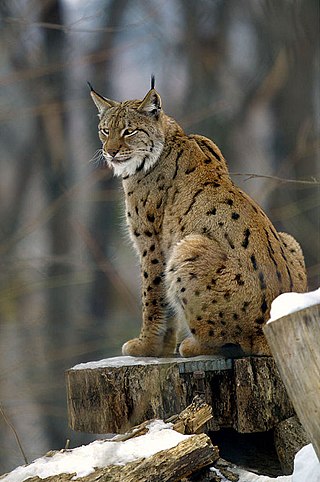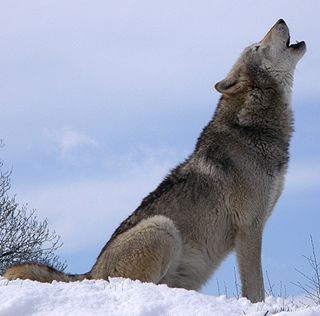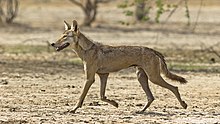
The moose or elk is the world's tallest, largest and heaviest extant species of deer and the only species in the genus Alces. It is also the tallest, and the second-largest, land animal in North America, falling short only of the American bison in body mass. Most adult male moose have broad, palmate antlers; other members of the deer family have pointed antlers with a dendritic ("twig-like") configuration. Moose inhabit the circumpolar boreal forests or temperate broadleaf and mixed forests of the Northern Hemisphere, thriving in cooler, temperate areas as well as subarctic climates.

The wolf, also known as the gray wolf or grey wolf, is a large canine native to Eurasia and North America. More than thirty subspecies of Canis lupus have been recognized, including the dog and dingo, though gray wolves, as popularly understood, only comprise naturally-occurring wild subspecies. The wolf is the largest extant member of the family Canidae, and is further distinguished from other Canis species by its less pointed ears and muzzle, as well as a shorter torso and a longer tail. The wolf is nonetheless related closely enough to smaller Canis species, such as the coyote and the golden jackal, to produce fertile hybrids with them. The wolf's fur is usually mottled white, brown, gray, and black, although subspecies in the arctic region may be nearly all white.

Lucyan David Mech, also known as Dave Mech, is an American biologist specializing in the study of wolves. He is a senior research scientist for the U.S. Geological Survey and an adjunct professor at the University of Minnesota. He has researched wolves since 1958 in locations including northern Minnesota, Isle Royale, Alaska, Yellowstone National Park, Ellesmere Island, and Italy.

The Hokkaido wolf, also known as the Ezo wolf and in Russia as the Sakhalin wolf, is an extinct subspecies of gray wolf that once inhabited coastal northeast Asia. Its nearest relatives were the wolves of North America rather than Asia. It was exterminated in Hokkaido during the Meiji Restoration period, when American-style agricultural reforms incorporated the use of strychnine-laced baits to kill livestock predators. Some taxonomists believe that it survived up until 1945 on the island of Sakhalin. It was one of two subspecies that were once found in the Japanese archipelago, the other being the Japanese wolf.

The Eurasian wolf, also known as the common wolf, is a subspecies of grey wolf native to Europe and Asia. It was once widespread throughout Eurasia prior to the Middle Ages. Aside from an extensive paleontological record, Indo-European languages typically have several words for "wolf", thus attesting to the animal's abundance and cultural significance. It was held in high regard in Baltic, Celtic, Slavic, Turkic, ancient Greek, Roman, Dacian, and Thracian cultures, whilst having an ambivalent reputation in early Germanic cultures.

The tundra wolf, also known as the Turukhan wolf, is a subspecies of grey wolf native to Eurasia's tundra and forest-tundra zones from Finland to the Kamchatka Peninsula. It was first described in 1792 by Robert Kerr, who described it as living around the Yenisei, and of having a highly valued pelt.

The northwestern wolf, also known as the Mackenzie Valley wolf, Alaskan timber wolf, or Canadian timber wolf, is a subspecies of gray wolf in western North America. Arguably the largest gray wolf subspecies in the world, it ranges from Alaska, the upper Mackenzie River Valley; southward throughout the western Canadian provinces, aside from prairie landscapes in its southern portions, as well as the Northwestern United States.

The single predator-single prey relationship between wolves and moose on Isle Royale in Lake Superior is unique, and has been the subject of detailed study since 1958. Isle Royale, the principal island of Isle Royale National Park in Michigan in the United States, is an isolated island with little migration of animals into and out of the island, and as a national park, human interaction and impact on the two species is also limited. Both the wolves and the moose first became established populations on Isle Royale in the 1900s. The populations of both moose and wolves have shown repeated spikes and declines and have not settled to a balanced relationship. The moose populations have ranged from 500 to 2500 while the number of wolves has ranged from almost 50 to down to two. From 2018 to 2019, 19 wolves were released at Isle Royale in hopes of bringing stability to the ecosystem, and as of 2020, there are estimated to be 14 wolves remaining on the island.

Wolf attacks are injuries to humans or their property by any subspecies of wolf. Their frequency varies with geographical location and historical period, but overall gray wolf attacks are rare. Wolves today tend to live mostly far from people or have developed the tendency and ability to avoid them. The country with the most extensive historical records is France, where nearly 10,000 fatal attacks were documented from 1200 to 1920. There are few historical records or modern cases of wolf attacks in North America. In the half-century up to 2002, there were eight fatal attacks in Europe and Russia, three in North America, and more than 200 in south Asia. Experts categorize wolf attacks into various types, including rabies-infected, predatory, agonistic, and defensive.

WolfQuest is a 3D wildlife simulation video game originally developed by the Minnesota Zoo and game developer company Eduweb, and developed solely by Eduweb since 2013. The game's main purpose is to help players understand wolves and the roles they play in nature by being virtually incarnated as a gray wolf themselves. WolfQuest challenges players to learn about wolf ecology by living the life of a wild wolf in Yellowstone National Park.

The history of wolves in Yellowstone includes the extirpation, absence and reintroduction of wild populations of the gray wolf to Yellowstone National Park and the Greater Yellowstone Ecosystem. When the park was created in 1872, wolf populations were already in decline in Montana, Wyoming and Idaho. The creation of the national park did not provide protection for wolves or other predators, and government predator control programs in the first decades of the 1900s essentially helped eliminate the gray wolf from Yellowstone. The last wolves were killed in Yellowstone in 1926. After that, sporadic reports of wolves still occurred, but scientists confirmed in the mid-1900s that sustainable gray wolf populations had been extirpated and were absent from Yellowstone as well as 48 states.

The Interior Alaskan wolf, also known as the Yukon wolf, is a subspecies of gray wolf native to parts of British Columbia, the Northwest Territories, Interior Alaska and Yukon.

Pursuit predation is a form of predation in which predators actively give chase to their prey, either solitarily or as a group. It is an alternate predation strategy to ambush predation — pursuit predators rely on superior speed, endurance and/or teamwork to seize the prey, while ambush predators use concealment, luring, exploiting of surroundings and the element of surprise to capture the prey. While the two patterns of predation are not mutually exclusive, morphological differences in an organism's body plan can create an evolutionary bias favoring either type of predation.

The northern lynx is a medium-sized subspecies of the Eurasian lynx.

Wolf distribution is the species distribution of the wolf. Originally, wolves occurred in Eurasia above the 12th parallel north and in North America above the 15th parallel north. However, deliberate human persecution has reduced the species' range to about one-third, because of livestock predation and fear of wolf attacks on humans. The species is now extirpated in much of Western Europe, Mexico, and the contiguous United States, and completely from the British Isles and the Japanese archipelago. In modern history, the gray wolf occurs mostly in wilderness and remote areas, particularly in Canada, Alaska, the Northern United States, Europe and Asia from about the 75th parallel north to the 12th parallel north. Wolf population declines have been arrested since the 1970s, and have fostered recolonization and reintroduction in parts of its former range, due to legal protection, changes in land-use and rural human population shifts to cities. Competition with humans for livestock and game species, concerns over the danger posed by wolves to people, and habitat fragmentation pose a continued threat to the species. Despite these threats, because of the gray wolf's relatively widespread range and stable population, it is classified as Least Concern on the IUCN Red List. In Africa the population of wolves is limited to the northern regions with the African golden wolf north of the Sahara and the Ethiopian wolf in Ethiopia.

Wolves communicate using vocalizations, body postures, scent, touch, and taste. The lunar phases have no effect on wolf vocalisation. Despite popular belief, wolves do not howl at the Moon. Gray wolves howl to assemble the pack, usually before and after hunts, to pass on an alarm particularly at a den site, to locate each other during a storm or while crossing unfamiliar territory, and to communicate across great distances. Other vocalisations include growls, barks and whines. Wolves do not bark as loudly or continuously as dogs do but they bark a few times and then retreat from a perceived danger. Aggressive or self-assertive wolves are characterized by their slow and deliberate movements, high body posture and raised hackles, while submissive ones carry their bodies low, sleeken their fur, and lower their ears and tail. Raised leg urination is considered to be one of the most important forms of scent communication in the wolf, making up 60–80% of all scent marks observed.

Howling is a vocal form of animal communication seen in most canines, particularly wolves, coyotes, foxes, and dogs, as well as cats and some species of monkeys. Howls are lengthy sustained sounds, loud and audible over long distances, often with some variation in pitch over the length of the sound. Howling is generally used by animals that engage in this behavior to signal their positions to one another, to call the pack to assemble, or to note their territory. The behavior is occasionally copied by humans, and has been noted to have varying degrees of significance in human culture.

In ecology, hunting success is the proportion of hunts initiated by a predatory organism that end in success. Hunting success is determined by a number of factors such as the features of the predator, timing, different age classes, conditions for hunting, experience, and physical capabilities. Predators selectivity target certain categories of prey, in particular prey of a certain size. Prey animals that are in poor health are targeted and this contributes to the predator's hunting success. Different predation strategies can also contribute to hunting success, for example, hunting in groups gives predators an advantage over a solitary predator, and pack hunters like lions can kill animals that are too powerful for a solitary predator to overcome.
Wolves may suffer from various pathogens, both viral and bacterial, and parasite, both external and internal. Parasitic infection in wolves is of particular concern to people. Wolves can spread them to dogs, which in turn can carry the parasites to humans. In areas where wolves inhabit pastoral areas, the parasites can be spread to livestock.





















